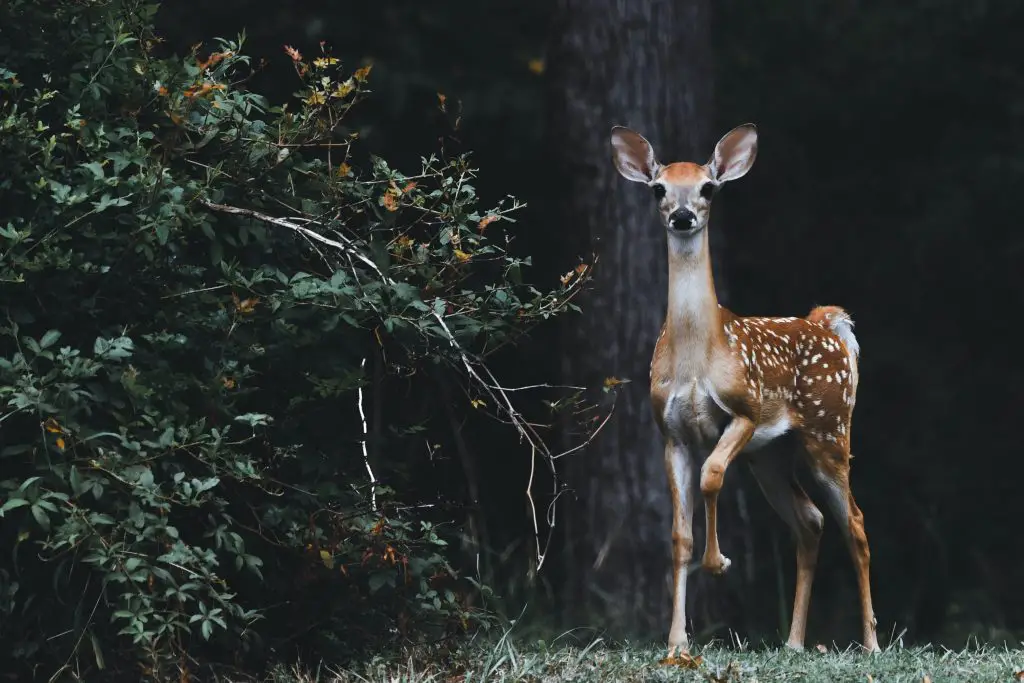Are Raspberries Deer Resistant? When people talk about deer-resistant plants, they often think about plants that grow in the ground and offer a low-hanging fruit or seed crop. While deer will eat vegetation in any form, there are some plants which they will not eat.
Despite what you may hear, raspberry bushes are not reliably deer-resistant. Though some varieties of raspberries and blackberries, for that matter, that are less likely to be eaten by deer which include those that have a greater number of thorns.
However, as the raspberries have large underground root systems they will survive a visit from the local deer population. But you are unlikely to get much of a harvest from the plant unless you put in some protection.
What Type Of Protection Can Be Put In Place To Protect Crops Against Deer?
In some areas of the world, deer are a problem for farmers. Deer are very intelligent and have excellent senses. They are able to find a weakness in a fence, but will rarely go out of their way to try to do so.
This means that the fence does not have to be a lot stronger than it needs to be, since the deer are not trying their hardest to get through the fence. This is a big economic advantage over other animals who try their hardest to break through all the time and put a lot of energy into finding a weak spot.
The most common type of fence used for deer is a simple mesh fence or a single-strand electric fence. However, the best fences to use in these circumstances where there is a large population of deer is a multiple-line electric fences that is eight to ten feet.
For the uninitiated the fencing height may seem excessive however deer are quite energetic and capable of leaping several feet in the air. Additionally, common methods used to deter other animals such as chemical repellents do not work well against deer. An example of deer fencing is provided below.

The most basic deer fencing that can be installed requires fence posts to be concreted into the ground at intervals of approximately 5 ft. The mesh size of the wire recommended is typically around 2 inches by 2 inches. To prevent the fence from being breached by the animals running into the fence it is common for two layers to be applied to the bottom few feet of the fence.
In cases where there are many deer around one common problem that can occur is the deer can rub its antlers up against for an extended period of time which can result in the post being worn down.
To prevent this from happening electric wire can be an effective way to deter deer from attacking the fence. To do this successfully a single strand of electric wire placed at a height of 30 inches is usually sufficient to deter the deer.
To train the animals to stay away place peanut butter on a fence that is lined with aluminum. Once they get stung, they will remember and hopefully stay away in the future.
For large populations of deer, you should use additional wires set at 10, 20 and 30 inches from the ground. And in extreme cases where the deer are particularly persistent using 2 electric fences maybe necessary. Most people set them 2 feet apart.
Irrespective of the type of fence being used it is advisable to tie streamers to the fence to ensure that the deer can see the fence clearly. This will prevent them from running through it accidentally.

Apart From Raspberries What Else Do Deer Eat?
What dear eat does depend on the specific species of deer. In somewhere like the UK, there are 6 species of deer that are herbivorous that generally feed on grasses, the leaves, and shoots of trees. To a lesser extent, the deer will also eat woody plants and sometimes bark when there isn’t much food around. Fruit and berries are also eaten when the deer can find them.
Are The Plants That Deer Won’t Eat?
Despite the deer giving the impression that literally everything is on the menu there are a range of plants that deer are allergic to or are poisonous which they will steer clear of. These plants can be be used strategically to reduce damage in a couple of different ways.
One strategy is to plant them outside of the protective fence to create an additional protective layer to deter the animals from coming in. These plants can also be inter planted between other plants as a form of protection. A list of plants that deer will not eat is provided below. This list comes from almanac.com.
| Botanical name | Common name |
| Achillea filipendulina | Yarrow |
| Aconitum sp. | Monkshood |
| Ageratum houstonianum | Ageratum |
| Allium sp. | Onion |
| Amelanchier laevis | Allegheny Serviceberry |
| Antirrhinum majus | Snapdragon |
| Armoracia rusticana | Horseradish |
| Artemisia dracunculus | Tarragon |
| Artemisia sp. | Silver Mound |
| Arisaema triphylum | Jack-in-the-pulpit |
| Asarum canadense | Wild Ginger |
| Asparagus officinalis | Asparagus |
| Aster sp. | Aster |
| Astilbe sp. | Astilbe |
| Berberis sp. | Barberry |
| Borage officinalis | Borage |
| Buddleia sp. | Butterfly Bush |
| Buxus sempervirens | Common Boxwood |
| Helleborus sp. | Lenten or Christmas Rose |
| Cactaceae sp. | Cactus |
| Calendula sp. | Pot Marigold |
| Caryopteris clandonensis | Blue Mist Shrub |
| Centaurea cineraria | Dusty Miller |
| Centaurea cyanus | Bachelor’s Buttons |
| Cleome sp. | Spider Flower |
| Colchicum sp. | Autumn Crocus |
| Consolida ambigua | Larkspur |
| Convallaris majalis | Lily of the Valley |
| Coreopsis verticillata | Threadleaf Coreopsis |
| Corydalis sp. | Corydalis |
| Cytisus sp. | Broom |
| Daphne sp. | Daphne |
| Dicentra spectabilis now classified as Lamprocapnos spectabilis | Bleeding Heart |
| Digitalis purpurea | Common Foxglove |
| Dryopteris marginalis | Wood Fern |
| Echinacea purpurea | Purple Coneflower |
| Echinops ritro | Small Globe Thistle |
| Endymion sp. | Bluebell |
| Eranthus hyemalis | Winer Aconite |
| Euphorbia marginata | Snow-on-the-Mountain |
| Euphorbia sp. (except ‘Chameleon’) | Spurge |
| Festuca glauca | Blue Fescue |
| Fritilaria imperialis | Crown Imperial, Fritilia |
| Galanthus nivalis | Snowdrops |
| Gypsophila sp. | Baby’s Breath |
| Helichrysum | Strawflower |
| Heliorope arborescens | Heliotrope |
| Hyssopus officinalis | Hyssop |
| Ilex opaca | American Holly |
| Ilex verticillata | Winterberry Holly |
| Iris sp. | Iris |
| Juniperus | Juniper |
| Lantana sp. | Lantana |
| Lavandula sp. | Lavender |
| Limonium latifolium | Statice |
| Lobularia maritima | Sweet Alyssum |
| Marrubium vulgare | Horehound |
| Melissa officinalis | Lemon Balm |
| Mentha sp. | Mint |
| Monarda didyma | Bee Balm |
| Myosotis sp. | Forget-Me-Not |
| Myrica pensylvanica | Bayberry |
| Narcissus sp. | Daffodil |
| Nepeta sp. | Catmint |
| Ocimum basilicum | Basil |
| Osmunda | Fern |
| Pachysandra terminalis | Pachysandra |
| Paeonia sp. | Peony |
| Papaver | Poppy |
| Perovskio atriplicifolia | Russian Sage |
| Picea glauca ‘Conica’ | Dwarf Alberta Spruce |
| Pimpinalla anisum | Anise |
| Pinus | Pine |
| Potentilla | Cinquefoil |
| Ranunculus sp. | Buttercup |
| Rhus aromatica | Fragrant Sumac |
| Rosmarinus officinalis | Rosemary |
| Rudbeckia sp. | Black-Eyed Susan |
| Ruta sp. | Rue |
| Salix | Willows |
| Salvia officinalis | Garden Sage |
| Stachys byzantina | Lamb’s Ear |
| Syringa vulgaris | Common Lilac |
| Tanacetum vulgare | Common Tansy |
| Teucrium chamaedrys | Germander |
| Thumus sp. | Thyme |
| Yucca | Yucca |
| Viburnum dentatum | Arrowwood Viburnum |
| Zinnia | Zinnia |
Relevant Articles
Blueberries Vs Raspberries: What Is The Difference?
How Many Raspberries Will One Plant Produce?
Are there different types of raspberries?
What Are The Easiest Berries To Grow?
